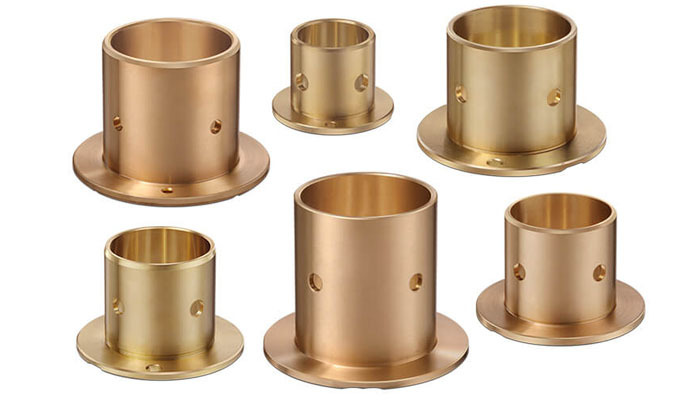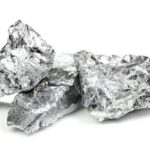Brass is an alloy made of copper and zinc; the proportions of zinc and copper can be varied to create a range of brasses with varying properties. Bronze is an alloy consisting primarily of copper, usually with tin as the main additive. It is hard and tough, and it was so significant in antiquity that the Bronze Age was named after the metal.
Admiralty brass contains 30% zinc, with 1% tin to inhibit dezincification in many environments. Alpha brasses with less than 35% zinc, are malleable, can be worked cold, and are used in pressing, forging, or similar applications. They contain only one phase, with face-centered cubic crystal structure. Alpha-beta brass (Muntz metal), also called duplex brass, is 35–45% zinc and is suited for hot working. It contains both α and β’ phase; the β’-phase is body-centered cubic and is harder and stronger than α. Alpha-beta brasses are usually worked hot. Aluminium brass contains aluminium, which improves its corrosion resistance. Red brass is both an American term for the copper-zinc-tin alloy known as gunmetal, and an alloy which is considered both a brass and a bronze. It typically contains 85% copper, 5% tin, 5% lead, and 5% zinc.
Aluminium Bronze
A type of BRONZE in which aluminium is the main alloying metal added to copper. Small amounts of other elements such as iron, manganese, nickel and silicon are added to impart various properties such as corrosion resistance or malubility. It fairs well in the marine enviroment.
Typical compostion: Copper 80% Aluminium 10% Nickel 5%
Iron 5%
Silicon Bronze
Has small amounts of silicon to allow it to be wrought or cold worked into a stronger alloy such as by rolling. It is also resistant to corrosion and therefore good for use in the marine enviroment. Typical compostion:
Copper 96% Silicon 3% Manganase 1%
Phosphor bronze
Well this one is different! Rather than Phosphor being the main alloy metal, it is used during manufacture to purify the melt and create a purer stronger type of bronze. Usually not more than
0.2% of the Phosphur is left in the metal. It is very corrosion resistant and therefore good in the marine environment.
Typical compostion: Copper 94.8%
Tin 5% Phosphorus 0.2%
Leaded Bronze
Leaded Gunmetal (LG2) Is a type of copper alloy that has a small amount of lead, tin and zinc added in similar quantities. It is not considered to be brass due to the amount of zinc being small. It has widespread use as a valve and through hull fitting material due to it’s good seawater resistance. It does not de-zincify in seawater despite having a zinc content. It is good for use in the marine environment.
Typical composition: Copper 85%
Lead 5% Tin 5% Zinc 5%
Bronze was especially suitable for use in boat and ship fittings prior to the wide employment of stainless steel owing to its combination of toughness and resistance to salt water corrosion. Bronze is still commonly used in ship propellers and submerged bearings.
In the 20th century, silicon was introduced as the primary alloying element, creating an alloy with wide application in industry and the major form used in contemporary statuary. Sculptors may prefer silicon bronze because of the ready availability of silicon bronze brazing rod, which allows color-matched repair of defects in castings. Aluminium is also used for the structural metal aluminium bronze.
It is also widely used for cast bronze sculpture. Many common bronze alloys have the unusual and very desirable property of expanding slightly just before they set, thus filling in the finest details of a mold. Bronze parts are tough and typically used forbearings, clips, electrical connectors and springs.
Bronze also has very low metal-on-metal friction, which made it invaluable for the building of cannon where iron cannonballs would otherwise stick in the barrel. It is still widely used today for springs, bearings, bushings, automobile transmission pilot bearings, and similar fittings, and is particularly common in the bearings of small electric motors. Phosphor bronze is particularly suited to precision-grade bearings and springs. It is also used in guitar and piano strings.
Unlike steel, bronze struck against a hard surface will not generate sparks, so it (along with beryllium copper) is used to make hammers, mallets, wrenches and other durable tools to be used in explosive atmospheres or in the presence of flammable vapors.
Bronze is used to make bronze wool for woodworking applications where steel wool would discolor oak.
Bearing Materials – Ceramics, Chrome Steels, Stainless Steels, and Plastics
The bearing industry uses different materials for the production of the various bearing components. The materials are processed to achieve desirable properties to maximize bearing performance and life. The materials described here are the most commonly used. Additional information can be found in the Technical Information Sheets for Balls, Closures, and Retainers.


